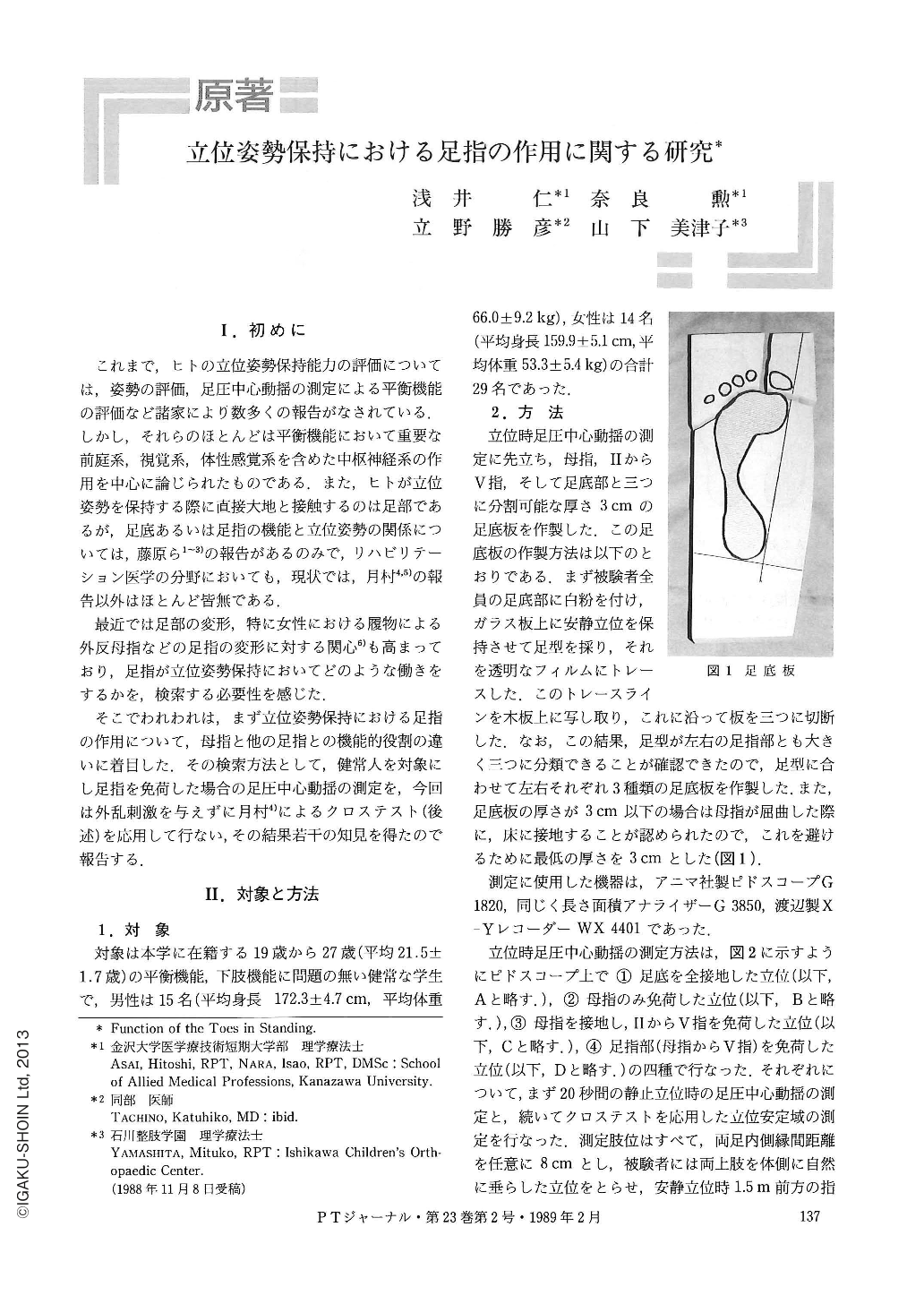1 0 0 0 立位姿勢保持における足指の作用に関する研究
- 著者
- 浅井 仁 奈良 勲 立野 勝彦 山下 美津子
- 出版者
- 医学書院
- 雑誌
- 理学療法ジャーナル (ISSN:09150552)
- 巻号頁・発行日
- vol.23, no.2, pp.137-141, 1989-02-15
Ⅰ.初めに これまで,ヒトの立位姿勢保持能力の評価については,姿勢の評価,足圧中心動揺の測定による平衡機能の評価など諸家により数多くの報告がなされている.しかし,それらのほとんどは平衡機能において重要な前庭系,視覚系,体性感覚系を含めた中枢神経系の作用を中心に論じられたものである.また,ヒトが立位姿勢を保持する際に直接大地と接触するのは足部であるが,足底あるいは足指の機能と立位姿勢の関係については,藤原ら1~3)の報告があるのみで,リハビリテーション医学の分野においても,現状では,月村4,5)の報告以外はほとんど皆無である. 最近では足部の変形,特に女性における履物による外反母指などの足指の変形に対する関心6)も高まっており,足指が立位姿勢保持においてどのような働きをするかを,検索する必要性を感じた. そこでわれわれは,まず立位姿勢保持における足指の作用について,母指と他の足指との機能的役割の違いに着目した.その検索方法として,健常人を対象にし足指を免荷した場合の足圧中心動揺の測定を,今回は外乱刺激を与えずに月村4)によるクロステスト(後述)を応用して行ない,その結果若干の知見を得たので報告する.
1 0 0 0 IR 言語表現とIconicity
- 著者
- 二枝 美津子 山下 美津子
- 出版者
- 京都教育大学
- 雑誌
- 京都教育大学紀要 (ISSN:03877833)
- 巻号頁・発行日
- vol.101, pp.37-49, 2002-09
同じ事態,状態を表現する場合,一つの言語表現が存在するのではなく,類似した表現がいくつか存在する。我々は,これらの表現のうちから一つを選び,それを記号化して表現する。それを選択する動機は,我々の経験的基盤を介して理解される。これと共通点を持つものにパースのIcon(類像)の考えがある。Iconは記号と指示物の間に有契性が存在する場合で,記号に本質的に備わった類似性という特性に基づいて指示物に言及する場合をいう。概念的距離が言語的距離に反映されることに注目し, Iconicityを言語学に適応したのはHaimanである。本論文では,使役表現,他動性を分析して事象に対する話者の概念的距離が言語表現に影響を与えるという根本的な考えを支持する。しかし,他動性を考察することで,概念的距離が離れれば,言語的距離が長くなるだけでなく,予測される表現から離れた表現になること,また,二重目的語構文と与格構文を比較することによって,概念的距離が離れれば,言語的距離が長くなるのではなく,動詞から離れた所に置かれることを示したい。また,その際の概念的距離の基準はHaimanの定めたものでは不十分であり,記号生産者と記号解釈者の間の語用論的前提が大いにかかわっていることを明らかにする。There are similar expressions, which reflect our way of cognition, and they are iconically motivated. The aim of this paper is to show that iconicity is defined as a degree of shared knowledge of a speaker and a hearer. Motivation of iconicity is reflected by conceptual distance. In this paper I will examine causative expressions and transitivity and support the principle suggested by Haiman. In the cases where the conceptual distance is recognized to be further, the linguistic distance is also greater. Moreover, the dative shift will be analyzed. The acceptability of dative or ditransitive construction depends on the some shared knowledge of a speaker and a hearer. When the conceptual distance is recognized to be further, the object is positioned farther from the verb. While the definition of conceptual distance is concerned with the separateness of the notions of cause and result and degree of force of effect, it will be clarified that it is above all determined by pragmatic presupposition.
